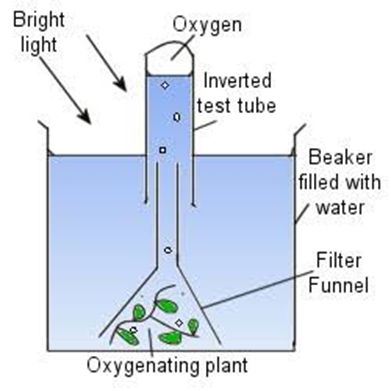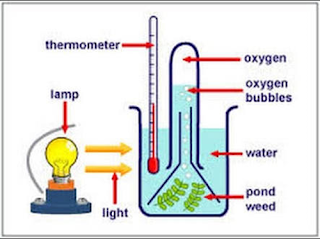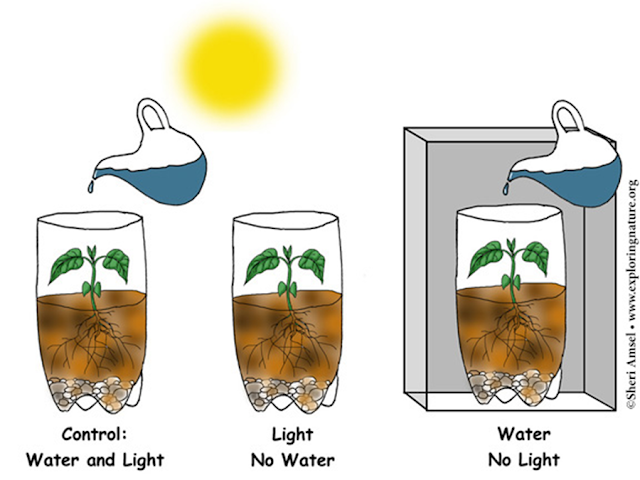Green plants make food by a chemical process called photosynthesis. Photosynthesis is a process of capturing and transforming the energy of sunlight into chemical energy. Plants use carbon dioxide and water to make glucose and release oxygen. Respiration on the other hand is a chemical process in which food is oxidized in an organism to produce energy for cell activities.
CHEMISTRY OF PHOTOSYNTHESIS
How much do you value green plants? Do you agree that we depend on plants for many things directly and indirectly? Green plants capture the energy of sunlight and transform it into chemical energy. This chemical process of capturing and transforming the energy of sunlight into chemical energy is called photosynthesis. This is the mechanism through which plants manufacture their own food by using water, carbon dioxide and sunlight absorbed by chlorophyll.
Through osmosis water is absorbed from the soil and transported to the green leaves where photosynthesis takes place. The most abundant and important photosynthetic pigment is chlorophyll. Green plants contain chlorophyll. Chlorophyll is the green pigment in plants. Carbon dioxidefrom the atmosphere diffuses into the leaf directly. It absorbs sunlight as a source of energy for the mechanism of photosynthesis to succeed. Photosynthesis takes place in the chloroplasts which are found mainly in the leaves.
The mechanism of photosynthesis is in two stages; light reaction (Kelvin reaction) and dark reaction.
1. Light reaction
During day time plants absorb sunlight using chlorophyll. In the leaf, light energy is converted into chemical energy. It is this chemical energy which is used to split water into hydrogen and oxygen. This reaction is reversible. It is during this reaction that oxygen is produced. The reaction is light controlled. It is sometimes called Calvin reaction because it was discovered by Melvin Calvin (1911-1997).
2. Dark reaction
In the second reaction the hydrogen from water chemically combines with carbon dioxide to form glucose. The process is long. This reaction is enzyme controlled and not light controlled. This is the reason why it is called dark reaction.
The chemical equation is as written below:

Factors necessary for photosynthesis to take place are carbon dioxide, water, light and chlorophyll. Sugar and oxygen are the products of this chemical reaction.
Oxygen is essential for living organisms because it is used in respiration. Respiration is the process by which living cells produce energy from the combination of foods, such as glucose, with oxygen. The oxygen is released as a waste product. The sugar is used in three ways:
i. Converted into starch and transported to other parts of the plant, in some plants it is stored in tubers or stems as food.
ii. Converted into cellulose for the cell walls.
iii. Used by the plant for its own respiration to provide energy for other processes.
In addition, plants use glucose molecules made from photosynthesis as a starting point for making other more complex substances which are passed on in the food chain when plants are eaten by animals.
EXPERIMENT 1
How to test for starch in a leaf?
First of all, we have to suggested materials to use in this test. Here is the list of materials to use: A leaf, alcohol, boiling tube, beaker, water, tripod stand, wire gauze, spirit burner or Bunsen burner, Petri dish, test tube, test tube rack, iodine solution, dropper, and forceps.
Once we have the materials, then we plan how to carry out this test. This is called the method or procedure of the test. The method (procedure) is as follows:
a. Detach a leaf from a plant that has been exposed to light and boil it in water for 1 to 4 minutes to make it soft and to stop the chemical reaction.
b. Boil the leaf in alcohol using a water bath to remove chlorophyll
c. Wash the leaf in warm water to remove alcohol and to make it soft since alcohol makes the leaf brittle.
A. Spread the bleached leaf on a white tile and add drops of iodine solution. The iodine solution turns blue/black if starch is present in the leaf.
EXPERIMENT 2
AIM
To show that oxygen is given out during photosynthesis
MATERIALS
Test tube and rack, wooden splint, pond weed, distilled water, sodium hydrogencarbonate, spatula, 250 cm3 beaker, filter funnel and plasticine.
PROCEDURE
a. The apparatus is set as shown above. Sodium hydrogencarbonate is added to the water to increase the availability of carbon dioxide.
b. The whole experiment is left in a well-lit place for a number of days and observation goes on.
RESULTS
Bubbles of a gas are released from the plant and collect in the test tube.
Observation:
Bubble of gas was noticed in experiment A. On passing a glowing splint over it, the splint was rekindle. In the set-up B, no bubbles were seen, and it could not rekindle a glowing splint.
Conclusion:
The gas that evolved in A is oxygen because, it is a known test for oxygen that oxygen rekindles a glowing splint.
| Experiment: To Demonstrate That Oxygen Is Released During Photosynthesis |
CONCLUSION
When the gas is tested with a glowing splint of wood, it relights. This shows that the gas is oxygen.
3. Factors that affect the rate of photosynthesis
The following factors have an effect on the rate of photosynthesis in green plants:
a. Light intensity
b. Carbon dioxide concentration
c. Temperature
d. Availability of water
Planning your own experiments
Use your knowledge of photosynthesis to plan experiments to show that carbon dioxide, chlorophyll, and light are necessary for photosynthesis. Each experiment will need a control. Here is an example:
AIM
To show that light is necessary for photosynthesis.
MATERIALS
PROCEDURE
a. The plant is left in the dark for 24 hrs before the experiment starts to remove the starch. This is called de-starching.
b. It is removed from the dark and put in sunlight for 24 hours but with part of the leaf covered by an aluminium foil. What is the role of aluminium foil in the experiment above?
Holt in foil
c. The leaf is then tested for the presence of starch.
RESULTS
The parts covered by the aluminium foil does not show the presence of starch but the part where there was a hole the iodine solution changes colour from yellow to blue black showing that starch is present.
This showed that starch was made in the presence of light but not where the leaf remained in the dark.
4. Importance of photosynthesis
To all animals, photosynthesis is very important. The sun is the main source of energy on which all creation depends. However, it is only plants that can utilize this energy. When plants are eaten energy is transferred to other forms. All heterotrophs depend on plants for energy. Even when dead remains of plants decay, energy is never lost but changed into another form which is nutrients in the soil. In conclusion we would say that all animals depend on photosynthesis as they depend on plants.
5. Photosynthesis and cellular respiration
Respiration involves a complicated chain of chemical breakdown of food to release energy. The energy produced is used for many chemical reactions in the living cell. There are two types of respiration – aerobic and anaerobic. Aerobic respiration involves the use of oxygen in the breakdown of glucose while anaerobic respiration does not use oxygen. Here we will look at aerobic respiration in plants.
Photosynthesis is the reverse of cellular respiration. Cellular respiration is the name given to the processes in cells that releases energy from food. Plants also use glucose molecules made from photosynthesis as starting point for making other more complex substances. These two chemical processes take place simultaneously in light in plants.
However, respiration takes place in the cytoplasm and mitochondria while photosynthesis takes place in the chloroplasts. In respiration, glucose and oxygen are used to produce carbon dioxide and water and release energy. In photosynthesis, carbon dioxide, water, and energy are used to produce glucose and to release oxygen. Cellular respiration releases chemical energy while photosynthesis captures light energy.
The chemical equation for cellular respiration is:
C6Hl206 + 602 ⟶ 6CO2 + 6H2O + energy
The word equation is:
Glucose + Oxygen → Carbon dioxide + Water + Energy
From the equation above, it is clear that for respiration to take place, food and oxygen must be taken in and reacts together. The end products of respiration carbon dioxide and water must be removed constantly.












